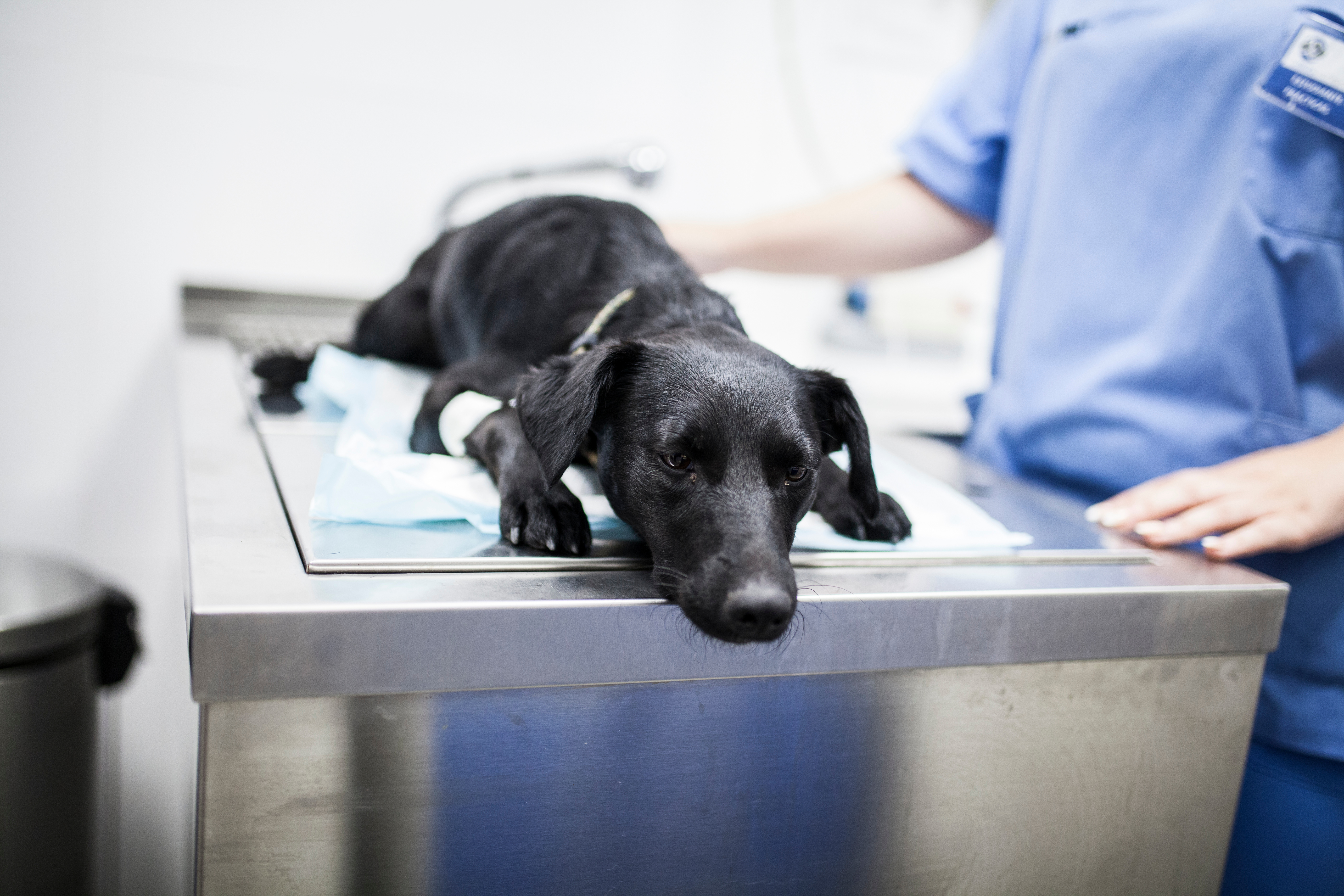Home | Emergency Care | Common Dog Emergencies
Common Dog Emergencies
Keywords:
Common Dog Emergencies
Medical emergencies occur suddenly and without warning. It is important for all pet owners to have a basic understanding of common veterinary medical emergencies and basic first aid for their pets. This article takes a moment to give some general guidelines for pet owners on how they can best support their dogs in the case of an emergency or if their pet is displayed out of ordinary behavior.
Some emergencies are obvious - a dog runs across the road and is hit by a car. Others may be just as serious, but not as obvious. For example, a German shepherd appears restless after a large meal and tries to vomit; unknown to the owner, this is the beginning of Gastric Dilatation and Volvulus (GDV), one of the most serious medical emergencies in large breeds.
While no one can be prepared for all emergencies, there are some simple steps you should follow and clinical signs to look for if your dog is ill or involved in an accident. Who knows, it just may save your pet's life.
Featured Resources

We Welcome New Patients!
We're always happy to give your furry friend care at our hospital. Get in touch today!
Contact Us
What to do in an emergency
Keep calm and try not to panic. Assess the scene for any additional threats to you or your pet. This is important for everyone's safety.
Keep your dog warm, as still and quiet as possible, and keep movement to a minimum, especially if there are neurological symptoms, broken bones, or any chance of a spinal injury.
Contact your veterinarian. Explain what has happened and follow the specific advice given.
To safely move or transport an injured dog, get somebody to help you. For a small dog, put it into its carrier (remove the top for easy and safe access to the carrier; don't push an injured dog through the small door or opening), or use a suitable container such as a strong cardboard box. For a larger dog, use a makeshift stretcher made out of some rigid material such as an appropriate-sized, sturdy piece of wood. Carefully maneuver the dog onto a blanket or coat so that it can be gently moved to the carrier, box, or stretcher. The blanket will help stabilize the neck and spine and prevent inadvertent biting or scratching from the injured pet.
Transport your dog to your veterinarian as soon as possible.

Are there any restraint tips that might be useful?
The majority of animals you will encounter will be panicked, disoriented, or injured. The stress of an emergency involving a pet or owner can cause an otherwise friendly animal to act aggressively. Although most panicky dogs respond to a calm, soothing voice and stroking of the head and shoulders, it is important to maintain your safety by using caution when approaching or touching an injured animal.
Muzzles: you can create a muzzle out of a leash, belt, rope, or pair of pantyhose. Make a loop in the cord and lasso it around the muzzle, tightening it to prevent the animal from biting. Dogs have only one muscle to open their jaw so once the jaw is closed, it is relatively easy to hold it safely shut. Dogs can breathe through their nostrils unless their nose is injured or obstructed.
Wrap the dog snugly in a blanket to minimize movement during transportation. Be very cautious of doing this if there is a possibility of broken bones or spinal injury.
If you suspect a spinal injury or broken bone, lay the dog on a board and immobilize it with straps or cords. Pay special attention to immobilizing the head and neck.
Are there any common emergencies that I should be prepared to handle?
Below is a list of common emergencies with a brief description of their clinical signs. This list is not intended to be comprehensive but should serve as a general guide.
"In any medical emergency or illness, be sure and contact your veterinarian as soon as possible for more specific recommendations and assistance."
In any medical emergency or illness, be sure and contact your veterinarian as soon as possible for more specific recommendations and assistance.
Anaphylaxis or anaphylactic shock - This is a severe allergic reaction characterized by sudden collapse and severe breathing difficulties. The first clinical signs are often swelling around the face or muzzle, the appearance of wheals or hives on the skin, vomiting or diarrhea, and restlessness. These clinical signs can quickly progress to collapse and breathing difficulty. Left untreated, severe anaphylactic shock can end in death. There are many causes for anaphylaxis that vary from insect stings, and contact allergies to injection reactions. You should seek veterinary care immediately if you think your pet may be experiencing anaphylaxis.
Automobile injury - Although you should make sure your dog has a clear airway, do not put your hand in the mouth of a conscious dog. Cover open wounds with whatever clean materials are available. Move your dog with care, supporting its body as much as possible, and use a blanket or other makeshift stretcher if at all possible. Immediately take your dog to a veterinary hospital.
Bites and fight wounds - These are particularly serious and require immediate veterinary intervention if:
A lot of blood has been lost or if bleeding is persistent and direct pressure fails to stop it.
Wounds involve the head, especially the eyes, ears, nose, or throat
There are penetrating Injuries in the region of the chest, abdomen, or groin
Bleeding - It can sometimes be difficult for pet owners to know when bleeding represents a veterinary emergency and when it can be treated at home. As a general rule of thumb, blood pumping out in spurts or dripping so fast that it makes a pool on the floor or soaks through a bandage within a few minutes is cause for alarm. Ears, feet, toenails, the tongue, and the nose can bleed severely and may need veterinary attention to stop the loss of blood as quickly as possible. Whenever possible, you should attempt to control bleeding by covering the wound with a clean absorbent compress and applying direct pressure. However, consult your veterinarian for specific first aid instructions on controlling bleeding on the way to the veterinary hospital.
Bloating, Gastric Dilatation and Volvulus - a dog that is experiencing an episode of "bloat" or gastric dilatation will develop a bulge behind the rib cage from a distended stomach full of gas. In some cases, the distended stomach will twist upon itself, causing a "volvulus", which will obstruct the entrance and exit of the stomach. Swelling of the abdomen becomes very pronounced, and the dog will rapidly collapse due to shock. In its early stages, the dog may show repeated, unsuccessful attempts to vomit. This is an emergency situation that requires immediate veterinary attention if the dog is to survive.
Breathing difficulty - if your pet is having difficulty breathing, especially if your dog is "open mouth breathing", you need to get to the veterinarian without delay. BE VERY CAREFUL -- dogs that are having difficulty breathing are prone to panic and even the gentlest dog may bite! Never put your fingers in the mouth of a choking dog.
Burns and scalds - Burns can be caused by heat such as a fire, or by caustic substances such as acids or alkalis (lye). Unless you witness these injuries, they may initially go unnoticed until a scab or an area of skin or hair loss is discovered. This is because the initial wounds are usually hidden by the dog's fur. If you see your pet get burned or scalded, cool the burned area by running water over the burn or covering it with cold wet towels. If a caustic substance caused the burn, rinse with cool water for 15 minutes to remove or dilute the caustic material and soothe the pain. If skin loss is noticed, protect the area with a clean covering. In all cases, contact your veterinarian immediately.
Convulsions or seizures - A seizure is a series of violent, uncontrolled spasms. Most seizures last for less than two minutes. If a seizure lasts more than five minutes or if several seizures occur in rapid succession, your dog requires immediate veterinary treatment to prevent permanent damage.
During the seizure, DO NOT put your hand in its mouth. The dog WILL NOT swallow its tongue. Protect the dog from injuring itself, but otherwise do not attempt to interrupt the seizure. Once your dog has recovered from the seizure, keep it warm and provide reassurance by talking calmly or patting him. Your dog will require veterinary attention to determine the cause of the seizures, but as long as the seizure wasn't prolonged, you can book the appointment at your earliest convenience. Diarrhea or vomiting that is persistent - Repeated or continuous vomiting or diarrhea, with or without blood, could be a sign of poisoning, an intestinal obstruction, or acute gastrointestinal infection. Dehydration is a major concern, especially in small dogs. Contact your veterinarian if you observe blood in the stool, if the vomiting or diarrhea persists beyond six to twelve hours or if your pet becomes less responsive or weak. Abdominal distension and repeated, unproductive attempts at vomiting are often an early indication of Gastric Dilatation and Volvulus. If you notice your dog repeatedly trying to vomit, DO NOT WAIT - get to the veterinarian immediately.
Contact your veterinarian before administering human medications. Do not force your pet to drink or eat. You may inadvertently give something that worsens your pet's condition
Eclampsia - Eclampsia is also known as hypocalcemia, milk fever, or puerperal tetany. It is a condition that affects nursing mothers, especially if their litter is large. It is caused by the depletion of calcium in the bloodstream from heavy milk production. In some cases, it may also occur during the later stages of pregnancy. Signs are vague and include restlessness, panting, increased salivation, and stiffness when moving. This can rapidly progress to muscle twitching and spasms, convulsions, pyrexia (high fever), and sudden death. Contact your veterinarian if you are concerned that your dog is developing eclampsia.
Eye injury- many eye injuries can cause blindness or a ruptured eye if left untreated. If the cornea is scratched or punctured, it will be very painful. To prevent further damage, do not allow your dog to rub its head on the carpet or scratch the eye. If a blow to the head causes the eyeball to come out of its socket, keep it moist with saline solution (e.g. contact lens solution) and protect it from direct injury. Sudden blindness or vision loss (your dog may start stumbling or bumping into things, or you might notice widely dilated pupils) may be a symptom of glaucoma. If your cat develops symptoms such as runny eyes, colored discharge from the eyes, squinting, sudden dilation of the pupils, or apparent blindness, get immediate veterinary treatment. DO NOT DELAY.
Heat stroke - This can happen at any time in hot, humid weather. It is frequently the result of leaving dogs in cars with too little ventilation. The signs are excessive panting, lethargy, and distress. Unconsciousness and death can quickly follow. If heat stroke occurs, cool your dog as quickly as possible by immersing it in a tub of cool water if it is small enough, by hosing it down with a garden hose if it is larger, or by applying cold wet towels to its body and legs. Avoid using ice or ice water because this may drop the temperature too quickly and cause additional complications. Animals that have been exposed to heat or smoke from a fire should be offered water as soon as they are stable. Take the dog to a veterinary hospital immediately (keep the car windows open during the trip) to ensure that there are no other problems.
Hemorrhagic gastroenteritis - This condition is characterized by severe bloody diarrhea and vomiting, along with weakness or collapse. This condition is serious and requires immediate veterinary attention.
Heart failure - Also called "heart attack", cardiac failure, and cardiac insufficiency, heart failure may go undiagnosed until the dog suddenly collapses or faints. As dogs age, they may develop a condition called congestive heart failure (CHF) which may affect either the left, the right, or both sides of the heart. Signs of impending heart failure include coughing (especially at night), difficulty breathing, bluish discoloration of the tongue (and other mucous membranes), decreased stamina, and exercise intolerance.
Exercise or excitement often immediately precedes the collapse. With the increased demand from the excitement, the inefficient heart is unable to pump blood fast enough, causing a severe lack of oxygen to the muscles and brain, which results in sudden collapse. If you observe any of these signs, contact your veterinarian immediately.
Injuries - Some injuries are medical emergencies, depending on the type and extent of wounds. If you suspect that your dog has a broken bone, immobilize the area and use a board or other support during transportation to the veterinarian. Any penetrating wound to the chest or abdomen and virtually any injury involving the eye should be regarded as a medical emergency. Injuries to the head or those causing difficulty breathing should also be treated as immediate emergencies.
Poisoning - Poisoning of any sort is an emergency. If you see your dog ingest a suspicious substance, call your veterinarian. Many different things in the house and garden are potentially toxic to dogs, including pesticides, chemicals, cleaners, and medications. Most poisonings occur without your knowledge. Clinical signs are variable and include excessive salivation, vomiting, diarrhea, seizures or collapse, skin damage due to caustic substances, etc. If a product label is available, check it for first aid instructions, such as whether to induce vomiting. You can usually induce vomiting with 5 ml (one teaspoon) of hydrogen peroxide orally or a teaspoon of salt placed in the back of the mouth. Keep a sample of the vomit for testing. Seek veterinary care as soon as possible to help reduce the absorption of toxins. Bring a sample of the suspected toxin with you, as well as any packaging. DO NOT INDUCE VOMITING UNLESS SPECIFICALLY DIRECTED TO DO SO BY YOUR VETERINARIAN.
Unconsciousness or collapse - This may occur with or without seizure activity. It often occurs without warning, such as in the case of sudden heart failure or following a blow to the head. Collapse should always be treated as a medical emergency.
Vomiting that is persistent - (see above, under diarrhea and vomiting)
What is shock?
Shock has many definitions. It is a complex systemic or whole-body reaction to a number of situations. These include acute loss of blood volumes such as hemorrhage, heart failure, and other causes of decreased circulation (e.g. severe and sudden allergic reaction and heat stroke). If not treated quickly and effectively, systemic shock may cause irreversible injury to body cells, and it can be fatal.
How do I recognize shock?
Signs include rapid breathing which may be noisy, rapid heart rate with a weak pulse, pale (possibly even white) mucous membranes (gums, lips, under eyelids), severe depression (listlessness), and cool extremities (limbs and ears). The dog may vomit. Shock requires immediate emergency treatment.
As a final note, after being involved in an emergency or accident, it is important that you take your dog for a veterinary examination as soon as possible, even if it appears to have recovered fully.
Featured Resources

We Welcome New Patients!
We're always happy to give your furry friend care at our hospital. Get in touch today!
Contact UsTips and Advice From Our Team
Looking for advice about caring for your pet? Our blog features helpful tips and educational material from our team to support your needs.



